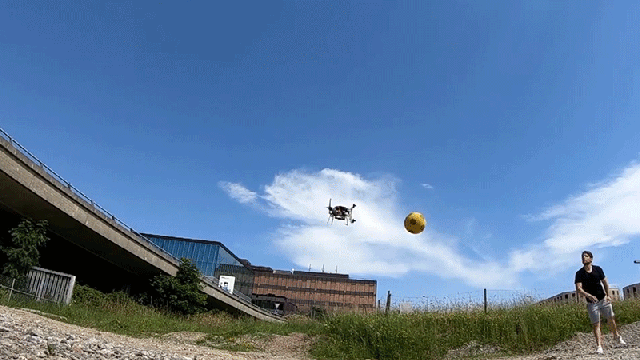The days of knocking an annoying drone out of the air with a precisely thrown rock might soon be over. Researchers at the University of Zurich have upgraded a drone with a special camera that can quickly spot approaching obstacles, allowing the craft to avoid them with reaction times as fast as 3.5 milliseconds.
Even drones being controlled by a skilled pilot can benefit from an obstacle avoidance system, which allows the craft to keep an eye out for obstacles in its flight path and automatically avoid a crash in the event a pilot doesn’t see a hazard or react fast enough to dodge it. Such systems are completely crucial for drones built to fly autonomously, whether it be for reconnaissance in dangerous areas after a natural disaster, or for companies like UPS that deliver products to consumers and have been developing flying drones as an alternative to four-wheeled delivery vehicles. Those big brown UPS trucks are impervious to seagulls who veer off course, but a package-laden drone would be easily knocked out of the sky by such a collision.
The cameras and image processing technologies that autonomous drones currently use to detect obstacles allow for reaction times within anywhere from 20 to 40 milliseconds, according to the UZH researchers. That’s fast, but when you factor in the speed of the drone itself (some can fly well over 150 miles per hour) many obstacles, such as a flying bird, another drone, or even a static object, 20 milliseconds isn’t enough to avoid a collision.
To improve reaction times, the researchers equipped a drone with what’s known as an event camera. Your typical video camera relies on a sensor that exposes all of its pixel elements at the same time before sending them along to be processed; objects can only be detected by algorithms once an entire frame—and often multiple frames—have been analysed. That’s what contributes to the delays in reaction times. An event camera, by comparison, has pixels that are individually “smart” and only pass along data to be processed when a change in what they’re seeing has been detected. If they don’t see anything new, they remain silent, allowing algorithms and processors to focus their efforts on pixels that have detected an approaching obstacle, which speeds up the entire process.
The UZH researchers developed their own custom algorithms that are able to recognise threats detected by the event camera after sampling footage from a very short amount of time, while taking into account the speed and direction of the drone itself. The results are reaction times reduced down to just 3.5 milliseconds, making a drone far more effective at dodging a fast-moving obstacle.
It’s an improvement, but not perfect just yet. From their testing, the researchers found a drone equipped with the new vision system could dodge a large ball thrown from three meters away at a speed of about 22 miles per hour more than 90 per cent of the time. Knowing the size of the incoming object ahead of time helped improve the results, but in the field a pair of event cameras on the drone, generating stereoscopic images, could allow them the craft to calculate the size of a threat all on its own. It can’t be used to dodge bullets just yet, but the current improvements in reaction times will allow autonomous drones to fly 10 times faster than they can now, meaning you potentially won’t have to wait as long for your drone-delivered pizza to arrive.
